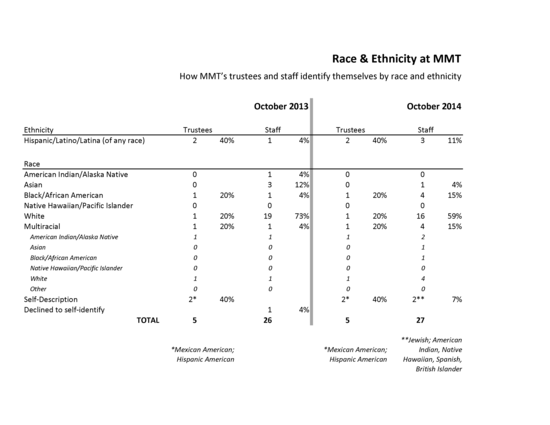One of the things we’ve learned through research Meyer Memorial Trust has done in the past few years is that many of the people who could most benefit from philanthropic dollars have the least access to them. It remains a source of great frustration: The level of foundation funding directly serving people of color is significantly lower than the percentage of population they represent. So one of the strategies we’re pursuing at Meyer to put our Vision, Mission and Values into practice and promote greater equity in Oregon is to pay closer attention to the demographic profiles of our nonprofit partners and those they serve. We want to know who is being reached and who is not.
Fifty organizations participated in our demographic pilot last autumn. We asked applicants for our Responsive Grants program to supply race and ethnicity data information on the populations the organization served in general and the populations the organization intended to serve through a Meyer-funded project, as well as the organization’s board and staff.
I want to thank them for their honesty.

Collecting demographic data can be logistically, intellectually and emotionally challenging work. Some of the applicants in our pilot remain skeptical that the data is necessary or valuable. Some, who say they do not discriminate based on race or ethnicity, feel being color blind is effort enough. And others are eager to start tracking the data themselves.
In the interest of transparency, we turned the lens on ourselves, too. We posted the results of a race and ethnicity survey our staff and trustees participated in last year on our website before asking our nonprofit partners to provide their own data. We updated the data this month. If you look at the charts, one thing is clear: We are a changing organization. A few people have left, a few people have been hired. But our demographic survey revealed something else, too. Our staffers are on the same journey of self-assessment we are asking our nonprofit partners to take. It is heartfelt. It is personal. It is self-defining. It is anything but black and white.
A year ago, we promised pilot participants we would work hard to figure out the best use for the data. Our program team and other Trust staff continue to explore how to incorporate more robust demographic data into our due diligence work. I especially want to call out Meyer's grants manager, Karissa Lowe, whose painstaking work collecting and compiling the demographic data offered our first real window into who our final beneficiaries really are — and some of the barriers to reaching them. At this stage, we’ve made no firm decisions about how the data Meyer collects in our grant applications will impact the distribution of our grant dollars. But we have decided that knowing more about who our grant dollars reach and how organizational leadership reflects and engages diverse communities are crucial lenses that we will continue to apply to our grantmaking.
We care about how nonprofit boards, staff and others involved in programming include and reflect communities and constituents. And we know that many Oregon nonprofits care about the same things. Going forward, we realize that some organizations will have an easy time tracking the racial and ethnic information of their boards, their staffs, the populations they serve generally and the populations they intend to serve with Meyer funding. For other organizations, the data collection is more challenging. Meyer is committed to meeting organizations and communities where they are.
We understand that while its population demographics are in flux, Oregon is not one of the more diverse states in the nation. Many areas in the state have scant representation of communities of color. We’re not asking organizations to serve people who aren’t there. But we are asking our nonprofit partners, who share our interest in reaching the many and diverse populations that make up Oregon, to be thoughtful about two things: ensuring that community members who could benefit from their programs and services have equitable access to them and reflecting Oregon’s ethnic and racial communities in the makeup of their organizations.
— Doug

